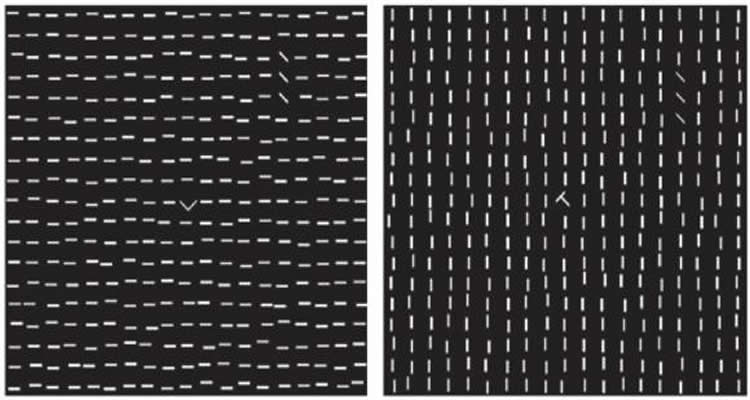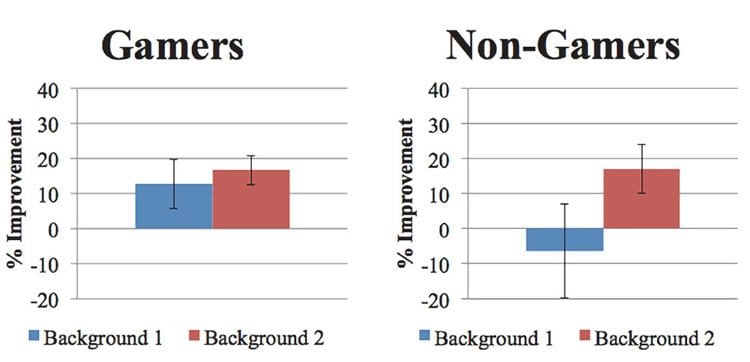Many studies show that video gamers perform better than non-gamers on certain visual tasks, like managing distractors and identifying targets, but a small new Brown University study provides gamers with some cognitive bonus points. The study results suggest that gaming not only improves their visual skill but also may improve their learning ability for those skills.
If the association the researchers document in the journal PLoS ONE indeed proves to be causal, then the implication would be that practice not only improves performance but also augments the capacity to improve performance further.
“When we study perceptual learning we usually exclude people who have tons of video game playing time because they seem to have different visual processing. They are quicker and more accurate,” said senior author Yuka Sasaki, associate professor (research) of cognitive, linguistic and psychological sciences at Brown. “But they may be in an expert category of visual processing. We sometimes see that an expert athlete can learn movements very quickly and accurately and a musician can play the piano at the very first sight of the notes very elegantly, so maybe the learning process is also different. Maybe they can learn more efficiently and quickly as a result of training.”
After all, video gaming has become a significant part of popular culture, making the study of gaming performance and its effects on perception and learning more important, said Aaron Berard, lead author and graduate student.
“In the last 20 years, video game playing as an activity has gone from simple entertainment to a serious hobby,” he said. “Video games are even played as a sport in some organizations today. It is important to recognize that more and more people are engaging in video games in modern society on a regular basis, which lends credit to why we should study gaming’s effects on the brain.”
Game on
To conduct the study, the researchers pitted nine frequent gamers against a control group of nine people who game rarely if ever. They participated in a two-day trial of visual task learning. Subjects were shown an on-screen “texture” of either visual or horizontal lines and had to quickly point out — in a fraction of a second — the one area where an anomalous texture appeared. In visual processing research this is a standard protocol called a “texture discrimination task.”

Prior studies have shown that most people can be trained to improve their performance on such tasks, but only if they are given enough time for the learning to “consolidate” in their mind, presumably as neural circuits embodying the learning take shape. If they move on to a second task too quickly, for example, that could interfere with their learning of the first one.
Sasaki, Berard, and their co-authors wanted to find out if gamers were better able to overcome this interference, compared to non-gamers. They therefore trained the subjects on a second similar task soon after training them on the first. If in the first task the main texture was horizontal, for example, the second time it was vertical, or vice versa.
The first day the subjects trained on each of the two tasks (in a randomized order). The next day they did each again (and again in a randomized order) so the researchers could assess whether they improved. To improve, a person had to reduce the milliseconds of time it took to discriminate the textures at a given level of accuracy.
What the researchers found was that gamers managed to improve performance on both tasks, while non-gamers did what was expected: They improved on the second task they trained on, but not on the first. Learning the second task interfered with learning the first.
The data show that gamers on average improved their combination of speed and accuracy by about 15 percent on their second task and about 11 percent on their first task. Non-gamers produced the same average 15 percent improvement on their second task, but they actually got a bit worse on the first task they learned, by about 5 percent. Despite the small number of participants, the results proved statistically significant.
Learning advantage?
The exact neural mechanisms underlying visual or perceptual learning are not yet known, Sasaki said, but the study suggests that gamers may have a more efficient process for hardwiring their visual task learning than non-gamers.

“It may be possible that the vast amount of visual training frequent gamers receive over the years could help contribute to honing consolidation mechanisms in the brain, especially for visually developed skills,” the researchers wrote.
Being certain will require more research. Importantly, the study doesn’t prove whether playing video games improves learning ability or whether people with an innate ability become gamers because they find gaming more rewarding. The study also has a stark gender imbalance between the nearly all-male gamer group and the nearly all-female non-gamer group. But the researchers could not find evidence in the literature for gender differences in perceptual learning that would make this disparity worrisome.
By documenting these and other apparent cognitive differences between gamers and non-gamers, the field is discovering that there is more to video games than merely passing the time, Berard said.
“A lot of people still view video games as a time-wasting activity even though research is beginning to show their beneficial aspects,” Berard said. “If we can demonstrate that video games may actually improve some cognitive functioning, perhaps we, as a society, can embrace newer technology and media with positive application.”
In addition to Sasaki and Berard, the paper’s other authors were Takeo Watanabe of Brown and former Brown student Matthew Cain, now of Brigham and Women’s Hospital and Harvard University.
The National Institutes of Health funded the research (grants R01EY015980, R01EY019466, R01MH091801).
Contact: David Orenstein – Brown University
Source: Brown University press release
Image Source: The images are credited to Watanabe lab/Brown University and are adapted from the press release
Original Research: Full open access research for “Frequent Video Game Players Resist Perceptual Interference” by Aaron V. Berard, Matthew S. Cain, Takeo Watanabe, and Yuka Sasaki in PLOS ONE. Published online March 30 2015 doi:10.1371/journal.pone.0120011
Frequent Video Game Players Resist Perceptual Interference
Playing certain types of video games for a long time can improve a wide range of mental processes, from visual acuity to cognitive control. Frequent gamers have also displayed generalized improvements in perceptual learning. In the Texture Discrimination Task (TDT), a widely used perceptual learning paradigm, participants report the orientation of a target embedded in a field of lines and demonstrate robust over-night improvement. However, changing the orientation of the background lines midway through TDT training interferes with overnight improvements in overall performance on TDT. Interestingly, prior research has suggested that this effect will not occur if a one-hour break is allowed in between the changes. These results have suggested that after training is over, it may take some time for learning to become stabilized and resilient against interference. Here, we tested whether frequent gamers have faster stabilization of perceptual learning compared to non-gamers and examined the effect of daily video game playing on interference of training of TDT with one background orientation on perceptual learning of TDT with a different background orientation. As a result, we found that non-gamers showed overnight performance improvement only on one background orientation, replicating previous results with the interference in TDT. In contrast, frequent gamers demonstrated overnight improvements in performance with both background orientations, suggesting that they are better able to overcome interference in perceptual learning. This resistance to interference suggests that video game playing not only enhances the amplitude and speed of perceptual learning but also leads to faster and/or more robust stabilization of perceptual learning.
“Frequent Video Game Players Resist Perceptual Interference” by Aaron V. Berard, Matthew S. Cain, Takeo Watanabe, and Yuka Sasaki in PLOS ONE. doi:10.1371/journal.pone.0120011.






